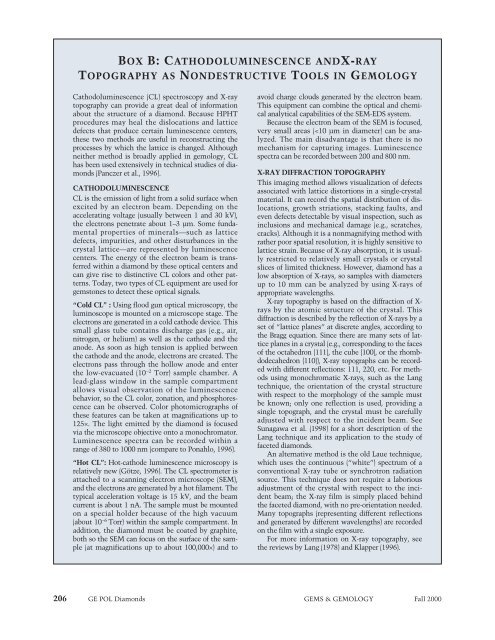Fall 2000 Gems & Gemology - Gemfrance
Fall 2000 Gems & Gemology - Gemfrance
Fall 2000 Gems & Gemology - Gemfrance
You also want an ePaper? Increase the reach of your titles
YUMPU automatically turns print PDFs into web optimized ePapers that Google loves.
BOX B: CATHODOLUMINESCENCE ANDX-RAY<br />
TOPOGRAPHY AS NONDESTRUCTIVE TOOLS IN GEMOLOGY<br />
Cathodoluminescence (CL) spectroscopy and X-ray<br />
topography can provide a great deal of information<br />
about the structure of a diamond. Because HPHT<br />
procedures may heal the dislocations and lattice<br />
defects that produce certain luminescence centers,<br />
these two methods are useful in reconstructing the<br />
processes by which the lattice is changed. Although<br />
neither method is broadly applied in gemology, CL<br />
has been used extensively in technical studies of diamonds<br />
(Panczer et al., 1996).<br />
CATHODOLUMINESCENCE<br />
CL is the emission of light from a solid surface when<br />
excited by an electron beam. Depending on the<br />
accelerating voltage (usually between 1 and 30 kV),<br />
the electrons penetrate about 1–3 µm. Some fundamental<br />
properties of minerals—such as lattice<br />
defects, impurities, and other disturbances in the<br />
crystal lattice—are represented by luminescence<br />
centers. The energy of the electron beam is transferred<br />
within a diamond by these optical centers and<br />
can give rise to distinctive CL colors and other patterns.<br />
Today, two types of CL equipment are used for<br />
gemstones to detect these optical signals.<br />
“Cold CL” : Using flood gun optical microscopy, the<br />
luminoscope is mounted on a microscope stage. The<br />
electrons are generated in a cold cathode device. This<br />
small glass tube contains discharge gas (e.g., air,<br />
nitrogen, or helium) as well as the cathode and the<br />
anode. As soon as high tension is applied between<br />
the cathode and the anode, electrons are created. The<br />
electrons pass through the hollow anode and enter<br />
the low-evacuated (10 –2 Torr) sample chamber. A<br />
lead-glass window in the sample compartment<br />
allows visual observation of the luminescence<br />
behavior, so the CL color, zonation, and phosphorescence<br />
can be observed. Color photomicrographs of<br />
these features can be taken at magnifications up to<br />
125×. The light emitted by the diamond is focused<br />
via the microscope objective onto a monochromator.<br />
Luminescence spectra can be recorded within a<br />
range of 380 to 1000 nm (compare to Ponahlo, 1996).<br />
“Hot CL”: Hot-cathode luminescence microscopy is<br />
relatively new (Götze, 1996). The CL spectrometer is<br />
attached to a scanning electron microscope (SEM),<br />
and the electrons are generated by a hot filament. The<br />
typical acceleration voltage is 15 kV, and the beam<br />
current is about 1 nA. The sample must be mounted<br />
on a special holder because of the high vacuum<br />
(about 10 –6 Torr) within the sample compartment. In<br />
addition, the diamond must be coated by graphite,<br />
both so the SEM can focus on the surface of the sample<br />
(at magnifications up to about 100,000×) and to<br />
avoid charge clouds generated by the electron beam.<br />
This equipment can combine the optical and chemical<br />
analytical capabilities of the SEM-EDS system.<br />
Because the electron beam of the SEM is focused,<br />
very small areas (


